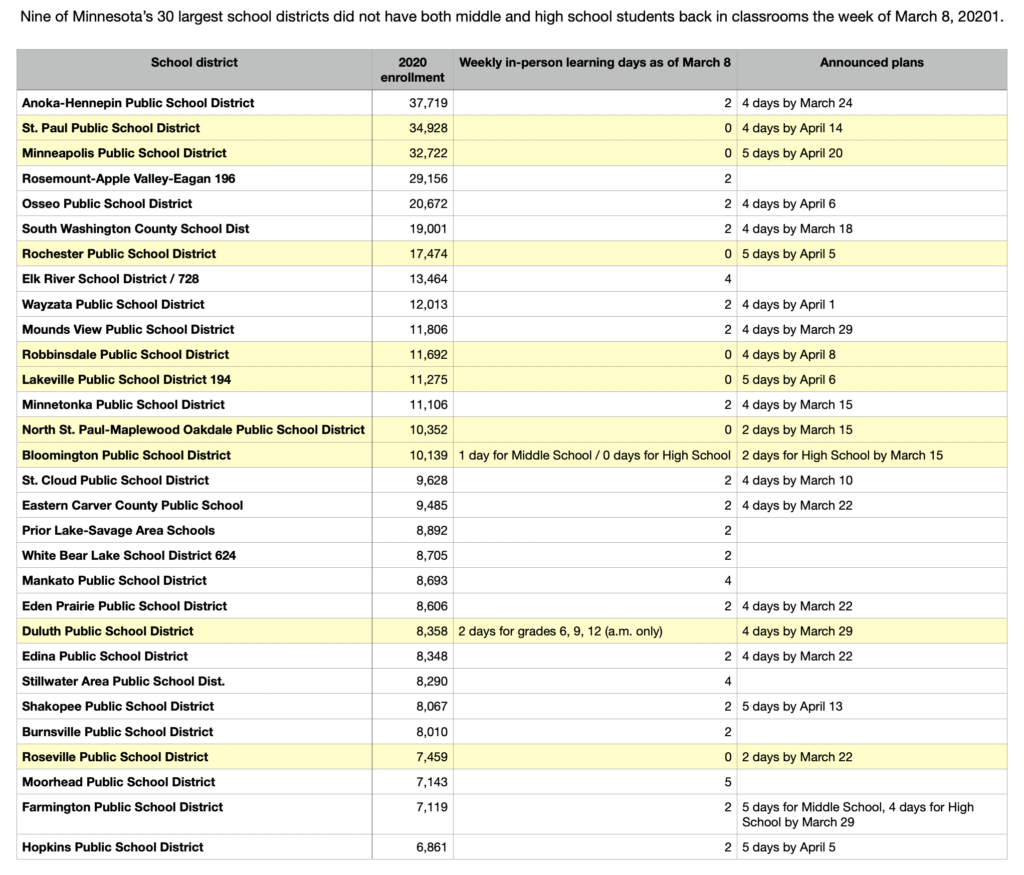Not all MN students are back in classrooms, 130 COVID studies make the case for schools reopening
Governor Walz’s expectation that all k-12 students be offered “some form of in-person learning” by March 8 wasn’t quite met.
According to the Minnesota Department of Education, about nine percent (47) of school districts and charter schools have self-reported that they are still in distance learning only. Among school districts themselves, around four percent are fully remote, according to a tracker created by the American Enterprise Institute.
Both middle and high schoolers in nine of Minnesota’s 30 largest districts have yet to return to their classrooms, reports the Pioneer Press.
All 30 large districts plan to have all schools open by April 20, at the latest; four will reopen later this month.
But the return for middle and high schoolers will still include some remote learning, under a hybrid learning model.
Only six of the 30 large districts plan to have their secondary students in classrooms every day of the week. Meanwhile, at least 17 will operate on four-day, in-person schedules, reserving the fifth day for teacher preparation and cleaning.
The others might not open more than two days a week.

Source: Josh Verges / Pioneer Press
What’s the hold up?
According to Deb Henton, the executive director of the Minnesota Association of School Administrators, the social distancing guidelines have made bringing back larger class sizes more challenging, continues the Pioneer Press.
The Anoka-Hennepin school district though, the largest in the state, brought back its middle and high schoolers for in-person learning two days a week as of March 8. The district announced secondary students will be in classrooms four days a week by March 24.
The St. Paul and Minneapolis districts (the second and third largest districts in the state) aren’t expected to reopen secondary classrooms until around the middle of April. And both districts have faced pushback from their local teachers’ unions regarding bringing students back into the classroom.
Millions of dollars have been allocated to Minnesota school districts in federal aid through the Elementary and Secondary School Emergency Relief (ESSER) fund signed into law at the end of December 2020. These funds can be used to address learning loss, prepare schools for reopening and testing, building repairs, and improving air quality in school buildings. (Nearly $123 billion more in recently approved federal funding will be allocated to states through a third round of ESSER funds — stay tuned for how much of this Minnesota will get.)
The St. Paul school district is estimated to receive nearly $84 million, respectively, from the second round of federal aid, according to estimates by the Minnesota Department of Education. The Minneapolis school district is estimated to receive around $78.5 million, respectively. Anoka-Hennepin is estimated to receive around $14 million. The dollars each district receive is largely driven by the number of low-income students each district serves.
Elementary schools were given the go-ahead to bring students back into classrooms in January and middle and high schools could resume in-person instruction in February. Community coronavirus case rates did not have to dictate school reopening plans as long as extra health and safety precautions were implemented.
A new review of research on reopening schools released by John Bailey, a visiting fellow at the American Enterprise Institute, shows that it’s safe to reopen schools and that the spread of COVID-19 as a result of in-person learning is low.
The findings from more than 130 U.S. and world studies that have researched coronavirus risks for children, transmissibility concerns, and the impact of school reopenings on community spread were gathered together by Bailey to make the evidence-based case for getting students back into school. With schools themselves not driving community transmission, the harm to students from missing school and the economic impact on families when students aren’t in school should be carefully considered, Bailey notes. The response to new variants of the coronavirus should be “doubling down” on safety measures, not closing schools.
Any public health benefit gained from school closures must be weighed against the significant — and potentially lasting — costs imposed on individual students and society as a whole. A growing body of research suggests children face greater health risks due to missed health screenings, food insecurity, and mental health challenges. Severe learning loss for many children, particularly children of color, will lead to lower educational attainment and lower future earnings.